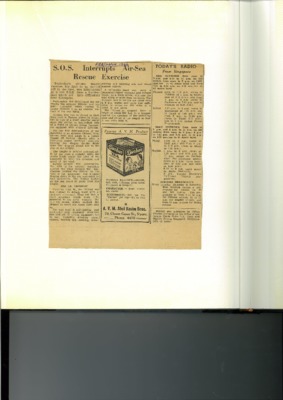Page 25 of D C Bradbury Scrapbook
Title
Page 25 of D C Bradbury Scrapbook
Description
A newspaper cutting titled 'S.O.S. Interrupts Air-Sea Rescue Exercise'. There is a handwritten annotation 'Feb/March 1946'. The article describes a Sunderland getting into problems near Singapore, separately from the air-sea rescue exercise, then details the dropping of the airborne lifeboat.
This item was sent to the IBCC Digital Archive already in digital form. No better quality copies are available.
This item was sent to the IBCC Digital Archive already in digital form. No better quality copies are available.
Date
1946
Temporal Coverage
Spatial Coverage
Language
Type
Format
One newspaper cutting on an album page
Publisher
Rights
This content is available under a CC BY-NC 4.0 International license (Creative Commons Attribution-NonCommercial 4.0). It has been published ‘as is’ and may contain inaccuracies or culturally inappropriate references that do not necessarily reflect the official policy or position of the University of Lincoln or the International Bomber Command Centre. For more information, visit https://creativecommons.org/licenses/by-nc/4.0/ and https://ibccdigitalarchive.lincoln.ac.uk/omeka/legal.
Contributor
Identifier
PBradburyDC17010025
Transcription
Abstract
[underlined] FEB/MARCH 1946[/underlined]
S.O.S Interrupts Air-Sea Rescue Exercise
Yesterday’s air-sea rescue exercise, the first to be carried out in the East, was interrupted by a real S.O.S. from a Sunderland which got into difficulties near Singapore.
Fortunately the Sunderland did not require the airborne lifeboat, and the giant Lancaster which carried it, finally dropped it as an exercise instead of the real thing.
Airman, who may be forced to ditch their craft in Eastern waters in future, can be sure of a much speedier rescue sine the arrival in South-East Asia of a flight of air-sea rescue Lancasters equipped with airborne lifeboats.
For the first demonstration of the launching of an airborne lifeboat, three airmen were sent adrift in a rubber dinghy off Katong. Shortly after, a Lancaster roared overhead evidently locating the dinghy. Smoke floats were then dropped ahead and to the rear of the dinghy.
The dinghy inflated automatically by gas from a cylinder while the smoke floats enable the pilot of the Lancaster to judge direction and speed of the wind.
Having secured this information the pilot of the aircraft travelling against the wind released the mechanism holding the lifeboat to the body of the Lancaster, and it came floating down to the sea suspended by four parachutes. The lifeboat landed on the sea about 60 yards from the dinghy.
3750 LB. LIFEBOAT
Weighting 3.750 lb., the lifeboat was first noticed to detach itself which a backwards
movement. Then out blew a small parachute which when fully distended in the wind released the four big chutes which enables the lifeboat to reach the water right side up.
The boat itself is self-righting and unsinkable with buoyancy chambers fore and aft. It carries equipment for 10 men, including drinking water, rations, medical kit, clothing, transmitting and receiving and visual distress signals.
A collapsible mast can carry a Bermudan-rigged mainsail and foresail which, in a fresh breeze, will take the boat along at more than six knots. The lifeboats now in service are fitted with a 8.h.p. engine and carry fuel sufficient to cruise for 650 miles at a speed of five knots.
The lifeboat is dropped from a height of about 800 feet. It is dropped against the direction of the prevailing wind and ahead of the dingy so that it can drift onto it.
[underlined] FEB/MARCH 1946[/underlined]
S.O.S Interrupts Air-Sea Rescue Exercise
Yesterday’s air-sea rescue exercise, the first to be carried out in the East, was interrupted by a real S.O.S. from a Sunderland which got into difficulties near Singapore.
Fortunately the Sunderland did not require the airborne lifeboat, and the giant Lancaster which carried it, finally dropped it as an exercise instead of the real thing.
Airman, who may be forced to ditch their craft in Eastern waters in future, can be sure of a much speedier rescue sine the arrival in South-East Asia of a flight of air-sea rescue Lancasters equipped with airborne lifeboats.
For the first demonstration of the launching of an airborne lifeboat, three airmen were sent adrift in a rubber dinghy off Katong. Shortly after, a Lancaster roared overhead evidently locating the dinghy. Smoke floats were then dropped ahead and to the rear of the dinghy.
The dinghy inflated automatically by gas from a cylinder while the smoke floats enable the pilot of the Lancaster to judge direction and speed of the wind.
Having secured this information the pilot of the aircraft travelling against the wind released the mechanism holding the lifeboat to the body of the Lancaster, and it came floating down to the sea suspended by four parachutes. The lifeboat landed on the sea about 60 yards from the dinghy.
3750 LB. LIFEBOAT
Weighting 3.750 lb., the lifeboat was first noticed to detach itself which a backwards
movement. Then out blew a small parachute which when fully distended in the wind released the four big chutes which enables the lifeboat to reach the water right side up.
The boat itself is self-righting and unsinkable with buoyancy chambers fore and aft. It carries equipment for 10 men, including drinking water, rations, medical kit, clothing, transmitting and receiving and visual distress signals.
A collapsible mast can carry a Bermudan-rigged mainsail and foresail which, in a fresh breeze, will take the boat along at more than six knots. The lifeboats now in service are fitted with a 8.h.p. engine and carry fuel sufficient to cruise for 650 miles at a speed of five knots.
The lifeboat is dropped from a height of about 800 feet. It is dropped against the direction of the prevailing wind and ahead of the dingy so that it can drift onto it.
Collection
Citation
Strait Times Press Ltd, Singapore, “Page 25 of D C Bradbury Scrapbook,” IBCC Digital Archive, accessed November 5, 2024, https://ibccdigitalarchive.lincoln.ac.uk/omeka/collections/document/18346.
Item Relations
This item has no relations.

